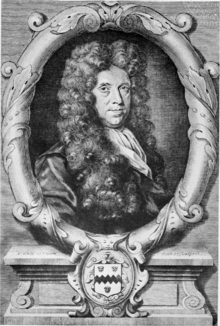Nehemiah Grew
Nehemiah Grew (26 September 1641 – 25 March 1712) was an English plant anatomist and physiologist, the "Father of Plant Anatomy".
Nehemiah Grew | |
|---|---|
 Nehemiah Grew | |
| Born | 26 September 1641 Mancetter Parish, Warwickshire |
| Died | 25 March 1712 (aged 70) London |
| Nationality | English |
| Alma mater | Leiden University |
| Scientific career | |
| Fields | Physiology |
Grew graduated from Pembroke College, Cambridge in 1661,[1] and ten years later took the degree of M.D. at Leiden University.
He began work on the anatomy of plants in 1664, and in 1670 his essay, The Anatomy of Vegetables begun, was communicated to the Royal Society. The following year he was elected a Fellow. In 1672, when the essay was published, he settled in London, and soon acquired an extensive practice as a physician.
In 1673 he published his Idea of a Phytological History, which consisted of papers he had communicated to the Royal Society in the preceding year, and in 1677 he succeeded Henry Oldenburg as Secretary of the Royal Society. He edited the Philosophical Transactions in 1678-1679, and in 1681 he published by request a descriptive catalogue of the rarities preserved at Gresham College.
In 1682 appeared his great work on the Anatomy of Plants, which also was largely a collection of previous publications. It was illustrated with eighty-two plates, with an appendix of seven papers mostly of a chemical character. The Anatomy is especially notable for its descriptions of plant structure. He described nearly all the key differences of morphology of stem and root, showed that the flowers of the Asteraceae are built of multiple units, and correctly said that stamens are male organs. Anatomy of Plants also contains the first known microscopic description of pollen.
Much of Grew's pioneering work with the microscope was done at the same time as that of Marcello Malpighi. The two reportedly borrowed freely from one another. Grew's work on pollen was more extensive than that of Malpighi. It led to the discovery that size and shape is different between species, whereas pollen grains within a species are all alike. This discovery is central to the field of micropaleontology.[2]
References
change- ↑ Venn J. & Venn J.A. (eds) 1922–1958. Nehemiah Grew. In Alumni Cantabrigienses 10 vols, online ed. Cambridge University Press. [1] Archived 2012-06-09 at the Wayback Machine
- ↑ Manten A.A. 1967. Lennart von post and the foundation of modern palynology (1967). "Lennart von Post and the foundation of modern palynology". Review of Palaeobotany and Palynology. 1 (1–4): 11–22. doi:10.1016/0034-6667(67)90105-4. hdl:1874/15873. S2CID 53000751.
{{cite journal}}: CS1 maint: numeric names: authors list (link)